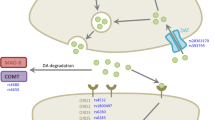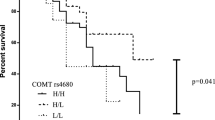Abstract
Levodopa is the most used drug to treat motor symptoms in Parkinson’s disease (PD). However, dopaminergic side effects such as nausea and vomiting may occur. Several evidences indicate a major role for dopamine receptors D2 (DRD2) and D3 (DRD3) in emetic activity. The aim of this study was to investigate the relationship of DRD2 rs1799732 and DRD3 rs6280 gene polymorphisms with gastrointestinal (GI) symptoms induced by levodopa in PD patients. Two hundred and seventeen PD patients on levodopa therapy were investigated. DRD2 rs1799732 and DRD3 rs6280 polymorphisms were genotyped by PCR-based methods. Multiple Poisson regression method with robust variance estimators was performed to assess the association between polymorphisms and gastrointestinal symptoms. The analyses showed that DRD2 Ins/Ins (prevalence ratio (PR)=2.374, 95% confidence interval (CI): 1.105–5.100; P=0.027) and DRD3 Ser/Ser genotypes (PR=1.677, 95% CI 1.077–2.611; P=0.022) were independent and predictors of gastrointestinal symptoms associated with levodopa therapy. Despite all the efforts to alleviate GI symptoms, this adverse effect still occurs in PD patients. Pharmacogenetic studies of GI symptoms induced by levodopa therapy have the potential to display new ways to better understand the molecular mechanisms involved in these side effects.
Similar content being viewed by others
References
Alves G, Forsaa EB, Pedersen KF, Dreetz Gjerstad M, Larsen JP . Epidemiology of Parkinson’s disease. J Neurol 2008; 255: 18–32.
Schapira AHV . The clinical relevance of levodopa toxicity in the treatment of Parkinson’s disease. Mov Disord 2008; 23: S515–S520.
Olanow CW, Agid Y, Mizuno Y, Albanese A, Bonuccelli U, Bonucelli U et al. Levodopa in the treatment of Parkinson’s disease: current controversies. Mov Disord 2004; 19: 997–1005.
Olanow CW, Lees A, Obeso J . Levodopa therapy for Parkinson’s disease: challenges and future prospects. Mov Disord 2008; 23: S495–S496.
Poewe W, Antonini A, Zijlmans JC, Burkhard PR, Vingerhoets F . Levodopa in the treatment of Parkinson’s disease: an old drug still going strong. Clin Interv Aging 2010; 5: 229–238.
Byrne KG, Pfeiffer R, Quigley EM . Gastrointestinal dysfunction in Parkinson’s disease. A report of clinical experience at a single center. J Clin Gastroenterol 1994; 19: 11–16.
Singaram C, Ashraf W, Gaumnitz EA, Torbey C, Sengupta A, Pfeiffer R et al. Dopaminergic defect of enteric nervous system in Parkinson’s disease patients with chronic constipation. Lancet 1995; 346: 861–864.
Woitalla D, Kassubek J, Timmermann L, Lauterbach T, Berkels R, Grieger F et al. Reduction of gastrointestinal symptoms in Parkinson’s disease after a switch from oral therapy to rotigotine transdermal patch: a non-interventional prospective multicenter trial. Parkinsonism Relat Disord 2014; 21: 199–204.
Li ZS, Schmauss C, Cuenca A, Ratcliffe E, Gershon MD . Physiological modulation of intestinal motility by enteric dopaminergic neurons and the D2 receptor: analysis of dopamine receptor expression, location, development, and function in wild-type and knock-out mice. J Neurosci 2006; 26: 2798–2807.
Tse GG, Kim BB, McMurtray AM, Nakamoto BK . Case of levodopa toxicity from ingestion of Mucuna gigantea. Hawaii J Med Public Health 2013; 72: 157–160.
Pfeiffer RF . Gastrointestinal dysfunction in Parkinson’s disease. Parkinsonism Relat Disord 2011; 17: 10–15.
Hardoff R, Sula M, Tamir A, Soil A, Front A, Badarna S et al. Gastric emptying time and gastric motility in patients with Parkinson’s disease. Mov Disord 2001; 16: 1041–1047.
Naylor RJ, Inall FC . The physiology and pharmacology of postoperative nausea and vomiting. Anaesthesia 1994; 49: 2–5.
Tanner CM, Goetz CG, Masaki KH . Autonomic nervous system disorders in Parkinson’s disease. In: Koller WC. (eds). Handbook of Parkinson’s Disease. Marcel Dekker: New York, NY, USA, 1992, pp 185–215.
Darmani NA, Crim JL . Delta-9-tetrahydrocannabinol differentially suppresses emesis versus enhanced locomotor activity produced by chemically diverse dopamine D 2/D3 receptor agonists in the least shrew (Cryptotis parva. Pharmacol Biochem Behav 2005; 80: 35–44.
Glare P, Miller J, Nikolova T, Tickoo R . Treating nausea and vomiting in palliative care: a review. Clin Interv Aging 2011; 6: 243–259.
Rieck M, Schumacher-Schuh AF, Altmann V, Francisconi CL, Fagundes PT, Monte TL et al. DRD2 haplotype is associated with dyskinesia induced by levodopa therapy in Parkinson’s disease patients. Pharmacogenomics 2012; 13: 1701–1710.
Rieck M, Schumacher-Schuh AF, Callegari-Jacques SM, Altmann V, Schneider Medeiros M, Rieder CR et al. Is there a role for ADORA2A polymorphisms in levodopa-induced dyskinesia in Parkinson’s disease patients? Pharmacogenomics 2015; 16: 573–582.
Hughes AJ, Daniel SE, Kilford L, Lees AJ . Accuracy of clinical diagnosis of idiopathic Parkinson’s disease: a clinico-pathological study of 100 cases. J Neurol Neurosurg Psychiatry 1992; 55: 181–184.
Arinami T, Gao M, Hamaguchi H, Toru M . A functional polymorphism in the promoter region of the dopamine D2 receptor gene is associated with schizophrenia. Hum Mol Genet 1997; 6: 577–582.
Abramson JH . WINPEPI updated: computer programs for epidemiologists, and their teaching potential. Epidemiol Perspect Innov 2011; 8: 1.
Tomlinson CL, Stowe R, Patel S, Rick C, Gray R, Clarke CE . Systematic review of levodopa dose equivalency reporting in Parkinson’s disease. Mov Disord 2010; 25: 2649–2653.
Hosmer DW Jr, Lemeshow S, Sturdivant RX . Model-building strategies and methods for logistic regression. In: Hosmer DW Jr, Lemeshow S, Sturdivant RX (eds). Applied Logistic Regression, 3rd edn Wiley: Hoboken, NJ, USA, 2013, pp 89–151.
Barnes JH . The physiology and pharmacology of emesis. Mol Aspects Med 1984; 7: 397–508.
Pleuvry BJ . Physiology and pharmacology of nausea and vomiting. Anaesth Intens Care Med 2009; 10: 597–601.
Horn CC . The medical implications of gastrointestinal vagal afferent pathways in nausea and vomiting. Curr Pharm Des 2013; 20: 2703–2712.
Seeman P, Wilson A, Gmeiner P, Kapur S . Dopamine D2 and D3 receptors in human putamen, caudate nucleus, and globus pallidus. Synapse 2006; 60: 205–211.
Jönsson EG, Nöthen MM, Grünhage F, Farde L, Nakashima Y, Propping P et al. Polymorphisms in the dopamine D2 receptor gene and their relationships to striatal dopamine receptor density of healthy volunteers. Mol Psychiatry 1999; 4: 290–296.
Lundstrom K, Turpin MP . Proposed schizophrenia-related gene polymorphism: expression of the Ser9Gly mutant human dopamine D3 receptor with the Semliki Forest virus system. Biochem Biophys Res Commun 1996; 225: 1068–1072.
Hellstrand M, Danielsen Ea, Steen VM, Ekman A, Eriksson E, Nilsson CL . The ser9gly SNP in the dopamine D3 receptor causes a shift from cAMP related to PGE2 related signal transduction mechanisms in transfected CHO cells. J Med Genet 2004; 41: 867–871.
Savitz J, Hodgkinson CA, Martin-Soelch C, Shen PH, Szczepanik J, Nugent A et al. The functional DRD3 Ser9Gly polymorphism (rs6280) is pleiotropic, affecting reward as well as movement. PLoS One 2013; 8: e54108.
Barnes NM, Bunce KT, Naylor RJ, Rudd JA . The actions of fentanyl to inhibit drug-induced emesis. Neuropharmacology 1991; 30: 1073–1083.
Scotto di Fazano C, Vergne P, Grilo RM, Bertin P, Bonnet C, Trèves R . Preventive therapy for nausea and vomiting in patients on opioid therapy for non-malignant pain in rheumatology. Therapie 2002; 57: 446–449.
Acknowledgements
This research was supported by grants from ‘Financiadora de Estudos e Projetos’ (FINEP 01.08.01230.00), ‘Conselho Nacional de DesenvolvimentoCientífico e Tecnológico’ (CNPq) and ‘Fundo de Incentivo à Pesquisa’ (FIPE–HCPA). The funding sources had no role in study design, collection, analysis and interpretation of data; in the writing of the report; and in the decision to submit the article for publication.
Author information
Authors and Affiliations
Corresponding author
Ethics declarations
Competing interests
The authors declare no conflict of interest.
Rights and permissions
About this article
Cite this article
Rieck, M., Schumacher-Schuh, A., Altmann, V. et al. Association between DRD2 and DRD3 gene polymorphisms and gastrointestinal symptoms induced by levodopa therapy in Parkinson’s disease. Pharmacogenomics J 18, 196–200 (2018). https://doi.org/10.1038/tpj.2016.79
Received:
Revised:
Accepted:
Published:
Issue Date:
DOI: https://doi.org/10.1038/tpj.2016.79
- Springer Nature Limited
This article is cited by
-
Genetics and Treatment Response in Parkinson’s Disease: An Update on Pharmacogenetic Studies
NeuroMolecular Medicine (2018)




